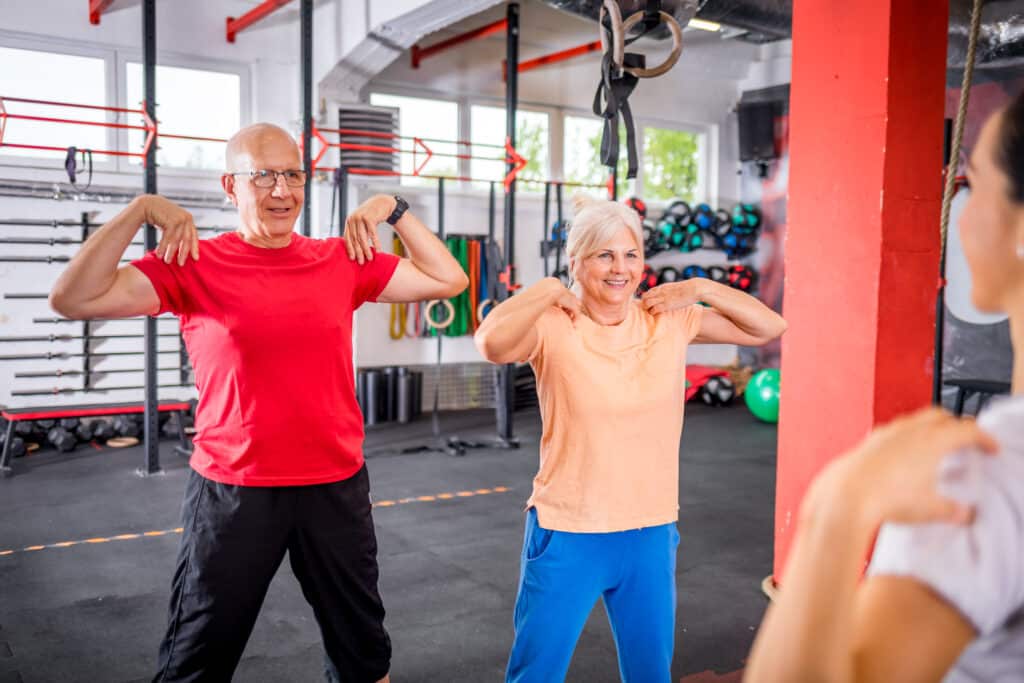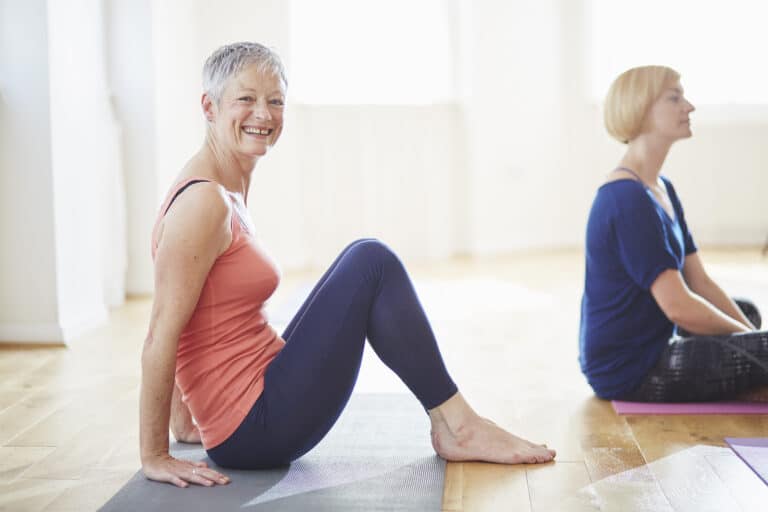Maintaining shoulder mobility is essential for everyday activities and overall quality of life, especially as we age.
This article explores the significant benefits of shoulder mobility exercises, which include reducing pain and inflammation, preventing injuries, improving posture, and enhancing performance in physical activities.
We’ll focus on various exercise types—dynamic stretches, static stretches, resistance exercises, and mobility drills—and outline how these movements can strengthen and stabilize the shoulder muscles, correct muscle imbalances, and increase joint mobility.
Exercises like shoulder circles, cross-body shoulder stretches, wall slides, and controlled articular rotations (CARs) are highlighted and detailed to ensure you understand how to do them properly and safely.
Benefits of Shoulder Mobility Exercises
Did you know that your shoulders are the most mobile joints in your body?
They’re essential for everything you do with your upper body, like putting on a shirt, throwing a ball, and even driving your car. That’s why it’s so important to keep them healthy.
As you get older, your shoulders become more susceptible to stiffness and loss of mobility for various reasons.1
Giving your shoulders the attention they need to be strong and flexible can help avoid or delay the need for surgery, improve your posture, and enhance your overall quality of life.
Here are a few significant reasons why shoulder mobility exercises should become a staple in your regular exercise routine:
- They can reduce pain and inflammation by reducing tension and pressure on the shoulder muscles and joints, making it easier to move around.
- Strengthening the stabilizing muscles in the shoulder can reduce the risk of injury. Limited shoulder mobility can lead to injuries and complications such as arthritis, nerve damage, and rotator cuff tears.
- They can improve your posture by correcting weak spots and imbalances in your shoulder muscles caused by hunching or slouching.
- They can enhance performance in physical activities by improving the range of motion in your shoulder joints, so you’ll be able to participate in your favorite activities with less restriction.
Improving your shoulders’ strength and mobility is a great way to ensure you can live fully and do what you love. However, knowing which exercises are best for you can be challenging.
Most of the older adults I’ve helped regain their shoulder mobility never even knew that exercise was one of the best ways to do it. This stresses the importance of working with an expert who knows what you should and shouldn’t do to improve your shoulder mobility, so don’t be afraid to ask for help!
Types of Shoulder Mobility Exercises

So, what are shoulder mobility exercises anyway? There are a few different types, which are usually classified into these main categories:
Dynamic Stretches
Dynamic stretches are a great way to begin any activity. They gently warm up your shoulders by moving them through their full range of motion.
Stretches such as arm circles or gentle swings across your body help awaken the muscles and prepare them for the day’s activities. They increase blood flow and flexibility, making them perfect before gardening, golfing, or even lifting groceries.2
Static Stretches
After you’ve moved a bit, static stretches are wonderful for maintaining the flexibility you’ve gained. In these stretches, you’ll extend your arm in a stretch and hold it still for about 15 to 30 seconds.
This helps your muscles and tendons adjust to being a bit longer, aids in relaxation, and can be very soothing. These stretches are particularly beneficial after physical activity as they help to calm the muscles and prevent stiffness, ensuring your shoulders remain flexible and pain-free.2
Resistance Exercises
Resistance exercises are key to keeping our shoulders flexible and strong. Using light weights, resistance bands, or even your body weight, these exercises help strengthen the muscles around your shoulders.
Movements like wall slides or lifting your arms to your sides can help to enhance muscle strength. This strength is crucial for everyday tasks such as lifting grandchildren, carrying shopping bags, or performing household chores with ease and less risk of injury.
Mobility Drills
Lastly, mobility drills focus on improving how your shoulder moves overall—not just making it stronger or more flexible.
These exercises help you control your movements and keep your shoulders moving smoothly. This can be particularly important for maintaining your ability to reach overhead or across the body without pain.
Simple drills, such as rotating your shoulder and arm through a full circle range of motion—known as CARs—train your shoulders to handle various movements, which helps in activities like dressing, reaching high shelves, or even swinging a tennis racket.
In my experience working with older adults, a combination of these shoulder mobility exercises is best. Mobility often requires strength, flexible muscles and tendons, and the trained control to move in and out of a specific range of motion.
Let’s look at some examples of my favorite shoulder mobility exercises.
The Best Shoulder Mobility Exercises
Getting started on your journey to better shoulder mobility might seem intimidating, but the benefits are always worth the effort. Here are a few of the best shoulder mobility exercises to help you get started on the right foot.
Shoulder Circles
Shoulder circles are dynamic stretches targeting the shoulder joint and rotator cuff. They help loosen and warm up your shoulder joint to improve flexibility and mobility. Better yet, they don’t require equipment, so they’re convenient and can be done anywhere.
- Stand with your feet shoulder-width apart and your arms slightly lifted at your sides.
- Slowly rotate your shoulder blades forward in a circular motion, starting with small circles and increasing the size and speed of the circles.
- Repeat 10-20 times, then switch directions so you’re rotating your shoulder blades backward. Repeat for 10-20 repetitions in this direction.
Remember not to force or jerk your shoulders, and stop the exercise if you feel pain or discomfort. Most patients find this one of the easiest and most effective exercises for keeping their shoulders moving throughout the day!
Behind the Back Shoulder Reach
This static stretch helps reduce muscle soreness and tension by relaxing and lengthening the muscles in the front of the shoulder and the biceps. Again, this stretch requires no equipment and can be done anywhere, making it easily accessible for most older adults.
- Standing tall, clasp your arms together behind you.
- Begin to straighten your arms, reaching your hands off your hips behind you.
- Pause when you feel a comfortable stretch in the front of your shoulders and chest.
- Perform 1 to 2 sets, holding the stretch for 30 seconds each time.
Wall Slides
Wall slides are a simple, beginner-friendly resistance exercise that targets your deltoids—the big muscle on the front and side of your shoulder. They strengthen your shoulder muscles and improve your stability while helping you maintain full range of motion in your shoulders.3
- Press a small hand towel against the wall with one hand. It is best to use a dry towel on an untextured, flat wall.
- Slide the towel up toward the ceiling, keeping pressure on the towel throughout the movement, then slide back to the start position.
- Do 15-20 repetitions with one hand, then switch to the other.
- This exercise can also be done with both hands at once.
Shoulder CARs (Controlled Articular Rotations)
As one of my all-time favorite shoulder mobility exercises, these mobility drills are an excellent way to increase the range of motion in your shoulder joints while helping to reduce muscle pain and stiffness.
- Sit or stand with your feet shoulder-width apart, with your arms resting by your sides. You can also sit on a bench or a chair, but keep your chest up and gaze forward.
- Raise one arm out in front of you with your palm facing down.
- Keep your elbow straight, and slowly rotate your right arm in a large circle. Keep rotating until your arm is above your head and your palm is facing forward.
- Now, continuing the circle, rotate your arm backward with your thumb pointing back.
- Gradually return to the starting position and rotate your palm so that it is facing down again when you reach your side.
- Repeat for 3 to 5 rotations, then switch and repeat with your opposite arm. Perform 1 to 2 sets on each side.
Remember, the goal of this exercise is less about warming up and more about exploring your shoulder mobility, so move slowly and try to feel where your restrictions are. As always, keep it pain-free!
The Impact of Shoulder Mobility Exercises
As a physical therapist, I’ve consistently seen my patients benefit from regularly performing shoulder mobility exercises. In addition to improved shoulder comfort, posture often improves, and activity levels increase.
But something else happens, too. As my patients feel more comfortable and capable in their bodies, I notice how their mood improves and their confidence is boosted. In my opinion, this is the most significant benefit of regular mobility exercise for older adults.
Key Takeaways
- The shoulders are highly mobile joints essential for many everyday activities, making maintenance crucial for quality of life.
- Regular shoulder mobility exercises can significantly reduce pain and inflammation and make daily movements easier.
- Strengthening the stabilizing muscles around the shoulders helps prevent injuries and complications such as arthritis and rotator cuff tears.
- These exercises improve posture by correcting muscle imbalances caused by habitual hunching or slouching.
- Enhanced shoulder mobility increases performance in various physical activities, allowing for greater participation in favorite hobbies.
- A mix of dynamic stretches, static stretches, resistance exercises, and mobility drills can provide comprehensive benefits for shoulder health.
- Exercises like shoulder circles, cross-body shoulder stretches, wall slides, and controlled articular rotations (CARs) effectively enhance shoulder mobility.
- Regular practice of these exercises improves physical health and boosts mood and confidence among older adults, highlighting the profound impact of maintaining mobility on overall well-being.
References
- Davis DL. Shoulder Dysfunction and Mobility Limitation in Aging. Adv Geriatr Med Res. 2023;5(3):e230008. doi: 10.20900/agmr20230008. Epub 2023 Nov 17. PMID: 38105787; PMCID: PMC10723811.
- Page P. Current concepts in muscle stretching for exercise and rehabilitation. Int J Sports Phys Ther. 2012 Feb;7(1):109-19. PMID: 22319684; PMCID: PMC3273886.
- Niederbracht, Yvonne1; Shim, Andrew L1; Sloniger, Mark A1; Paternostro-Bayles, Madeline1; Short, Thomas H2. Effects of a Shoulder Injury Prevention Strength Training Program on Eccentric External Rotator Muscle Strength and Glenohumeral Joint Imbalance in Female Overhead Activity Athletes. Journal of Strength and Conditioning Research 22(1):p 140-145, January 2008. | DOI: 10.1519/JSC.0b013e31815f5634






